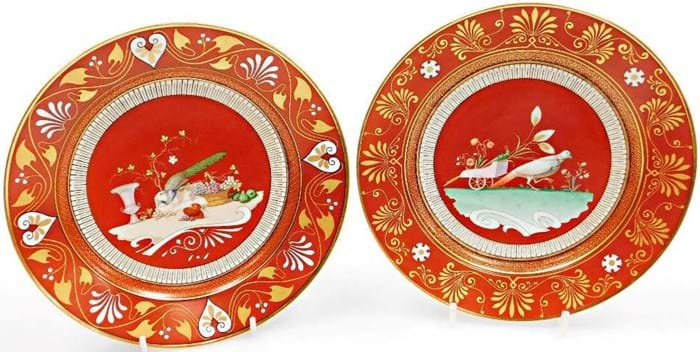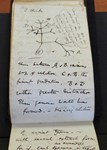The six elements from the rouge décor étrusque service made for Prince Napoleon (1822-91) in 1856 came for sale from a Leicestershire deceased estate.
The dinner and dessert service is thought to have been ordered by the nephew of Napoleon I (Napoleon-Joseph -Charles-Paul Bonaparte) for his mistress, the actress Elisabeth Félix (1821-58), better known only as Mademoiselle Rachel.
Delivered on October 18, 1856, it was to be used in the ‘salle à manger pompéienne’ in the ‘Etruscan’ house the Prince had built on the east side of the Avenue Montaigne in Paris.
The Sèvres factory archives contain full records of the order. The dessert pieces – the most splendidly decorated part of the commission – consisted of 72 assiettes priced at an average of 76 francs each.
The subjects were taken from ancient wall paintings (some were adapted from engravings in Antichità d’Ercolano) with a variety of different gilt border decorations of stylised anthemion and honeysuckle palmettes. Six painters and a gilder worked on the service with each piece marked with a crowned letter N in red. A full discussion appears in Aileen Dawson’s French Porcelain A Catalogue of the British Museum Collection (1994), where a similar dessert-plate is pictured.
Only a relatively small number of plates from this service have so far come to light, with less than half a dozen previously sold at auction in the past 30 years. It is thought the service was sold as part of a twoday auction in Paris that followed Mademoiselle Rachel’s untimely death in 1858.
Golding Young & Mawer had given its six plates an original estimate of £2000- 3000 before receiving a kind nod from a specialist who pointed them in the direction of another example with fuller cataloguing sold for £5000 at Christie’s in May 2017.
They attracted commission bidding from a number of interested parties at up to £30,000 before a brief exchange between the underbidder (online from China) and the successful buyer in Paris. A 24% buyer’s premium was charged.
Born at Trieste in the Austrian empire, Prince Napoleon was the second son of Jerome, King of Westphalia, the youngest brother of Napoleon, and his second wi fe Catha r i na of Wurttemberg. He was a close adviser to his first cousin, Napoleon III of France.
When he died in 1891 his Pompeian architectural fantasy was demolished.
















